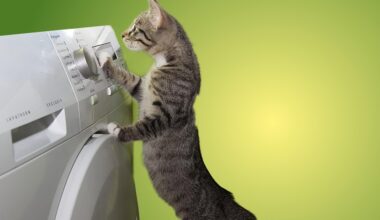How Seasonal Diet Changes Can Support Cat Exercise
As the seasons change, our feline friends require a reevaluation of their diet to support their exercise needs. Cats are obligate carnivores, and their nutritional needs can vary based on activity levels influenced by seasonal shifts. In the warmer months, indoor cats are often less active, while outdoor adventurers may have heightened energy levels. As such, choosing the right food that aligns with these changes is crucial. Seasonal dieting can ensure that they remain healthy and active. For instance, summer may require higher hydration through wet food, while winter might necessitate a caloric boost to maintain warmth. Also, understanding the ingredients in your cat’s food can significantly impact their performance and energy levels. Regular consultations with veterinarians can help monitor weight and activity level, ensuring the best dietary choices. Explore various brands that adjust their formulas seasonally to cater to your cat’s nutritional needs, and consider their preferences when making changes to maintain their interest in meals. Lastly, don’t forget treats, but moderation is key to avoid an unbalanced diet.
Exercise for cats is just as important as their diet, particularly in relation to the seasons. In the cooler months, indoor activities should be structured, prompting your cat to remain engaged and physically active. Interactive toys and puzzle feeders can also stimulate intellectual engagement, keeping your cat healthy during extended indoor periods. In spring and summer, outdoor adventures invite natural exercise opportunities, yet ensuring safety is essential. Always supervise outdoor time, as wildlife and traffic can pose risks. Consider setting up a safe enclosed play area on your patio or backyard, giving them the joys of the outdoors without danger. Be sure to include scratching posts, climbing trees, and accessible hiding spaces for them to explore. Balanced exercise also aids with weight maintenance, helping to prevent diseases, especially as cats age. While daily play sessions are important, integrating new routines can spice up their exercise regime. Movement encourages a better understanding of their surroundings which ultimately benefits both mental and physical health. Regular varying activities can prevent boredom and stimulate natural hunting behaviors.
Understanding Seasonal Behavior Changes
As the seasons change, so do the behaviors and physical activity levels of your cat. During summer, many cats become more playful, engaging in longer play sessions, especially if they have access to a safe outdoor space for exploration. In contrast, colder months can trigger more sedentary behaviors, prompting owners to adjust play routines accordingly. Understanding these patterns is helpful in choosing the right activities for their exercise needs. Pay attention to how your cat interacts with the environment, and adapt playtime to match. For example, consider introducing new toys or rotating old ones to sustain interest. Cats may also take advantage of the sunlight in winter, basking instead of exercising; providing stimulating toys can counteract this. Additionally, behavioral changes might demand different approaches; for instance, a cat might be less inclined to play vigorously. Therefore, augmenting quiet engagement activities, such as gentle grooming, can foster a bonding experience and promote physical well-being. Creating a watchful environment throughout the year enriches their physical and mental health and ensures they receive adequate exercise.
Nutrition plays a pivotal role in supporting a cat’s exercise needs across seasons. Each season brings different requirements concerning aromatic flavors and textures. In spring and summer, feeding your cat light meals can enhance stamina, while heavier, more caloric diets are beneficial when the temperature dips. Knowing how to balance this diet can actively support your cat’s energy needs. The benefits of ensuring your feline is regularly hydrated cannot be overstated, especially during the summer months when overheating becomes a significant risk. Utilizing pet-specific water fountains can encourage hydration, contributing positively to their exercising capability. Paying attention to the protein sources in their food ensures they receive necessary nutrients pivotal in energizing their playful behaviors. Opt for quality ingredients, ensuring that every bite supports their overall health. Besides providing the right food, treats can also play a role in preventing boredom and encouraging exercise; however, moderation is critical. Treats should complement the primary diet rather than overwhelm it. Adjusting calories in treats can help maintain your cat’s ideal weight throughout the year.
Engaging Indoor Activities
During colder months, it often becomes challenging to provide sufficient exercise for indoor cats, demanding creativity and resourcefulness. Indoor play not only helps exercise but keeps your cat mentally stimulated. Try using laser pointers, feather wands, or even balls of crumpled paper, which can be stimulating when thrown or batted around. Interactive toys that require your cat to solve puzzles for treats can satisfy their hunting instincts while providing essential mental challenges. Building an indoor obstacle course can also spark engagement, involving climbing, jumping, and searching. In winter, cozy spaces by the window may captivate your cat’s attention while enhancing their environment. Active play sessions need not be prolonged; short, frequent (10-15 minutes) bursts can yield positive effects on their physical health. This encourages natural hunting behavior and exercise, key components affecting their overall well-being. Remember to rotate toys frequently to maintain their interest, as cats quickly get bored with the same playthings. Lastly, consider regular, themed playdates with other felines if possible, stimulating interactive play while also providing social interaction.
As spring approaches, many pet owners prepare for transitioning their cat’s routine and diet towards brighter days. This period often encourages outdoor exploration, leading to increased physical activity levels. Introducing gradual diet changes can support enhanced energy levels and optimal weight throughout this active period. Slowly transitioning provides your cat time to adjust to new foods, minimizing digestive upset. Select foods with seasonal ingredients or lighter protein options to boost energy without compromising nutrition. Analytical factors such as age, activity level, and special dietary needs also should guide diet revisions. Additionally, enhancing outdoor access is essential; setting designated play areas within your yard can promote safe explorations of natural environments. Ensure that time outdoors is complemented with ongoing indoor stimulation to maintain balanced activity levels. Providing safe outlets for climbing, jumping, and exploring encourages healthy exercise. Crafting engaging activities integrating their natural instincts fosters growth and well-being. Basic training sessions can also benefit their mental engagement, ensuring they remain active and fulfilled as you support their seasonal transition. Understanding these adjustments benefits both cats and owners throughout the spring and summer months.
Monitoring Weight and Health
Keeping an eye on your cat’s weight and overall health is essential throughout seasonal changes and dietary adjustments. Regular vet visits are critical, as they can help track weight fluctuations and spot any potential issues that may arise. Additionally, relying on a balanced diet tailored to their specific seasonal exercise needs is paramount. Monitoring your cat’s body condition score (BCS) can provide vital insight into whether dietary and exercise routines are effective. Ideal cat body shapes allow for gentle indentations around their waist, while their ribs shouldn’t be prominent. If your cat shows signs of weight gain or loss, adjusting their food portions or exploring more engaging exercise methods becomes crucial. Partnering with your veterinarian ensures that any changes enhance your cat’s lifestyle and leads to positive health outcomes. They can recommend the appropriate amounts of calorie intake reliant on life stage and activity levels, adapting accordingly to seasonal habits. Taking the time to ensure your cat remains healthy and active throughout seasonal transitions leads to a happier, longer life together.
Ultimately, understanding and adapting your cat’s exercise routine and dietary needs according to seasonal shifts is vital for maintaining their health. Recognizing their behaviors can inform necessary adjustments, helping keep them engaged and active. Creating an enriching environment, whether through indoor play sessions during winter or outdoor exploration during warmer months, will provide essential stimulation. Always prioritize quality when it comes to food choices, ensuring ideal nutrition and hydration are met. Cats may thrive optimally with attention to their physical and mental wellness, leading to better quality lives. Each season introduces unique challenges and opportunities for feline health; therefore, it’s essential to remain proactive about creating these experiences. Through careful monitoring and adaptation, owners can foster a happier and healthier pet well-suited to the changing seasons. Being mindful of the importance of exercise and nutrition can significantly enhance their behavior, helping prevent medical concerns. Ultimately, providing love, attention, and engagement throughout the seasonal periods results in cherished companionship with a happy, vibrant, and healthy cat.


